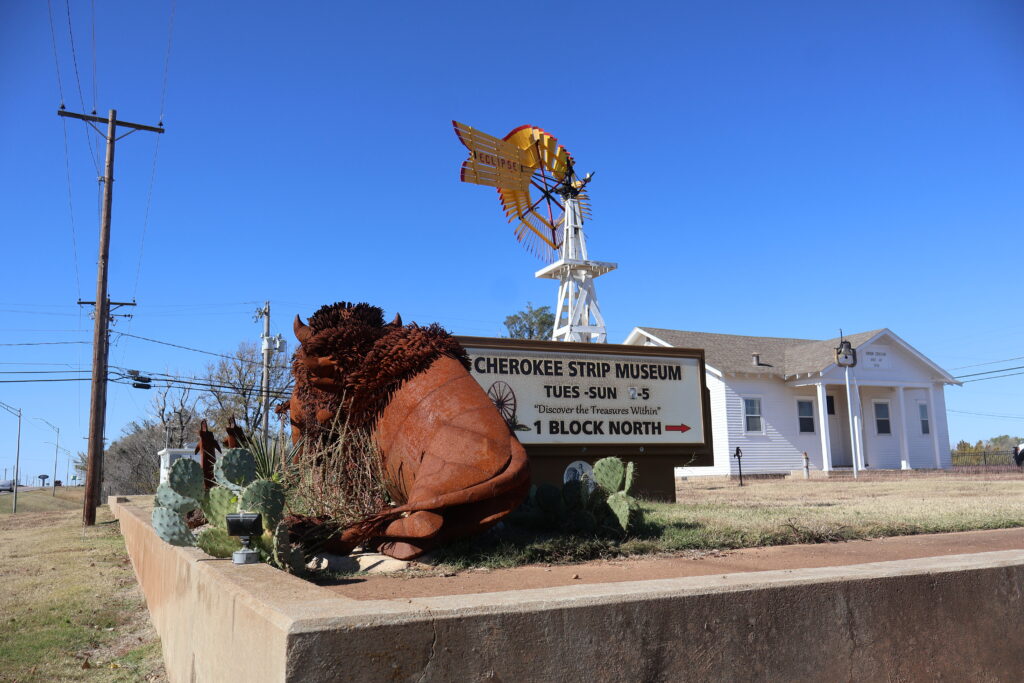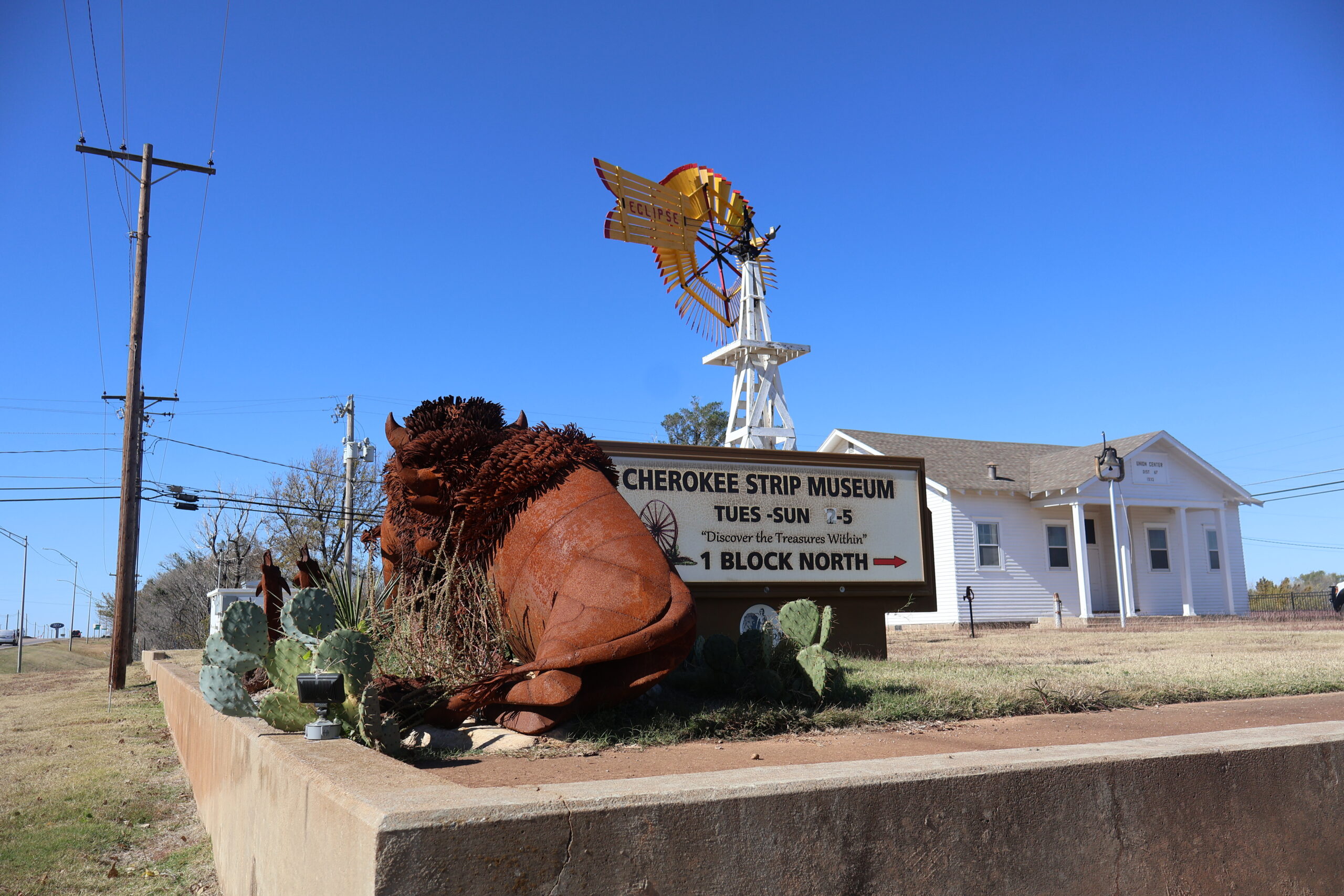A visit with Rose Blunk
Rose Blunk works at the Cherokee Strip Museum. In the past she has been on the board, but she still does a lot of work for the museum today, such as helping write grants.
“I just have a big interest in this museum,” she said, “and we have come a long way. I kind of have a mantra called ‘educate and entertain,’ but I’m really high on education.”
The museum does a lot of educational and out-reach programs. The latest program was about the “slinky seven.”
This program, just before Halloween, was a historical look at the seven men, all dead now, who met secretly years ago to plan to have a correctional center built in Alva. These seven men were the force behind bringing the Bill Johnson Correctional Center to Alva, They called themselves the “slinky seven.”
Blunk wrote a script for each of seven current community members (most of them descendants of the original seven), who memorialized these men at the Talking Tombstones event.
“It was a teaching experience because a lot of people do not know how we got the correctional center … how it came about,” she said. “But there was a lot of background stuff that was done, a lot of contacts, and that’s one of the educational things that we like to teach about, and I like to teach about.”
Each year the Cherokee Strip Museum invites all the fifth graders in the Alva school system to a day at the country school located south of the museum. The girls are invited to wear long dresses. The children bring their lunches in a syrup buckets as was the custom in a bygone era.
They have a teacher for the one-room school all day. They play old games at recess such as red rover and drop the handerchief.
They also experience the traveling music teacher. The country schools only used to have a music teacher come once a week, then Blunk comes in to teach the students how to dance the Virginia reel.
“We do some little songs and then they have recess,” she said. “But that’s another educational project that we think exposes the kids to what our ancestors did and really the statement that I think the museum does is they preserve the culture, the history, the traditions, the artifacts and the stories not only of past generations, but I hope it goes into the future. And I hope everybody that comes up here gets a kind of a bug to get interested.”
Blunk answered some questions about the Cherokee Strip Museum and museums in general.
Q: Do you think museums are still relevant?
A: Well, yes, that’s what we’re kind of doing I’m mostly talking about ours now.
It’s very relevant by teaching Just the about the people and what they’ve done.
We have acquired a new bunch of artifacts. They’re stuffed animals of all the animals in northwest Oklahoma, so that would be relevant.
We offer field trips once in a while, and we’ll get a bus trip up and we’ll go and tie in history with today. I would say, yes, they’re relevant, if you’re active and seek the information.
I keep saying educate, educate and educate. That’s what we want to do, and teaching and piquing the interest.
Sometimes a kid will come up here [and see] … these stuffed animals and fish, and that’ll just push his interest, and he’ll really become interest and want to come back. That’s what we really are hoping to arouse — an interest to learn.
Q: Do you see a lot of a high schoolers or college students come in here often?
A: Not as much as we’d like now. We do have some college kids that come in here for research once in a while.
Another point, I want to talk about is we are a good place to come and research, not as the old type research in the library, but to research and look at things. We’re very available.
But we don’t see as many as we’d like, but we are hoping bringing that fifth-grade class through here maybe will arouse some interest. We’re trying.
Q: What do you think makes this museum special and unique?
A: Well, all the little special programs we have and these special field trips.
We took a field trip over when the movie came through [“Killers of the Flower Moon,” 2023] about the Osage and how the Osage Indians struck oil, and everybody moved in and swindled them. We took a bus trip over there. It was relevant. It was wonderful. Everybody just hit at the right time.
I think our field trips make this real special. We’ve been to salt mines in Hutchinson [Kansas]. We’ve been in a lot of places. We’re always having little programs that we want to try to involve the community and pique the interest.
Q: If you could convince college students or high schooler to get more involved in museums, how would you do it?
A: I think by having more programs and more special programs is I guess the only way that I would know, but I wish I had that answer.
By starting early though I think that’s the best way, We did have participation when we did the Talking Tombstones. The art class at Alva High made the tombstones for us. So, they were involved and knew what they were for
Q: How does seeing all the artifacts that represent the history of Oklahoma in the museum impact the community?
A: It’s, fantastic, and we need to be pursuing it more. Well, it may be more younger adults because even I didn’t get interested in history until later.
Q: What is your favorite thing about this museum?
A: The POW room. … [During World War II] we had a prisoner of war camp here. It was at the fairgrounds and there’s still a VFW building out there. It was the officers’ quarters. [The prisoners] came into the train depot north of town, and they marched them all the way up to the fairgrounds.
[After the war] when they closed it down, we got some of the artifacts. In fact, we have a film made by Homer Jones of the prisoners walking by. They weren’t supposed to film it, but we can see them [the prisoners] walking by the soldiers. He [Jones] hid in the grass and filmed this, and we have a copy. We have a picture of that.
Our POW room has artifacts, [including] a map made by one guy who was going to break out. That’s our crown jewel.
We have display here of a young lady who become second runner up to Miss America. We have a room now; it looks different than the rest of our stuff because a professional company came out and put it together. It’s more modern looking, but it means a lot to us because she was from Alva Oklahoma.

The Cherokee Strip Museum is located on 14th Street in Alva, just off Oklahoma Boulevard. The school house here is used for fifth graders who spend a day learning what life was like long ago in Oklahoma. The main museum, an old hospital, is located just north of the school. The property also features a large barn and another large building that houses anique farm equipment and a small chapel that can be rented for weddings and other events. The museum offers a few other spaces the community can rent.

